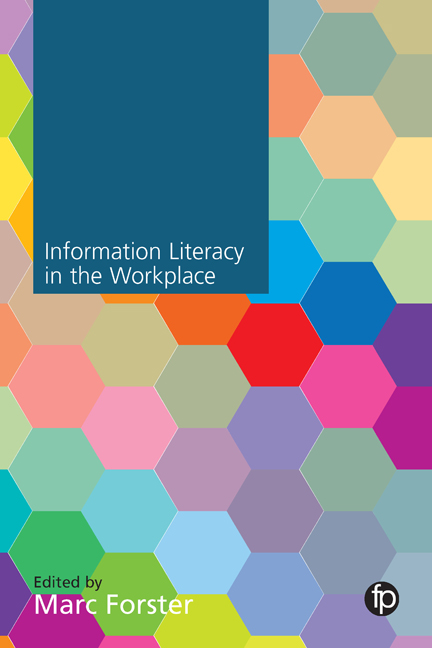Book contents
- Frontmatter
- Contents
- Figures and tables
- Contributors
- Foreword
- 1 Information Literacy and the workplace: new concepts, new perspectives?
- 2 How is Information Literacy experienced in the workplace?
- 3 Information Literacy and the personal dimension: team players, empowered clients and career development
- 4 From transaction to transformation: organizational learning and knowledge creation experience within Informed Systems
- 5 Virtuality at work: an enabler of professional Information Literacy
- 6 Determining the value of Information Literacy for employers
- 7 Information Literacy's role in workplace competence, ‘best practice’ and the ethics of professional obligation
- 8 Learning within for beyond: exploring a workplace Information Literacy design
- 9 Developing information professional competences in disciplinary domains: a challenge for higher education
- 10 The ‘hidden’ value of Information Literacy in the workplace context: how to unlock and create value
- 11 The ‘Workplace Experience Framework’ and evidence-based Information Literacy education
- References
- Index
8 - Learning within for beyond: exploring a workplace Information Literacy design
Published online by Cambridge University Press: 08 June 2018
- Frontmatter
- Contents
- Figures and tables
- Contributors
- Foreword
- 1 Information Literacy and the workplace: new concepts, new perspectives?
- 2 How is Information Literacy experienced in the workplace?
- 3 Information Literacy and the personal dimension: team players, empowered clients and career development
- 4 From transaction to transformation: organizational learning and knowledge creation experience within Informed Systems
- 5 Virtuality at work: an enabler of professional Information Literacy
- 6 Determining the value of Information Literacy for employers
- 7 Information Literacy's role in workplace competence, ‘best practice’ and the ethics of professional obligation
- 8 Learning within for beyond: exploring a workplace Information Literacy design
- 9 Developing information professional competences in disciplinary domains: a challenge for higher education
- 10 The ‘hidden’ value of Information Literacy in the workplace context: how to unlock and create value
- 11 The ‘Workplace Experience Framework’ and evidence-based Information Literacy education
- References
- Index
Summary
This chapter will discuss:
• how the intensification of work and creation of new ways of working can present librarians with challenges in terms of creating Information Literacy (IL) education that provides scaffolding for students’ transitions into professional or vocational practice.
• how by addressing this need, librarians must balance students’ transitions at both ends of the process – into higher education or vocational settings, and then into the workplace. This complexity requires a recasting of pedagogical practices to accommodate changes in the nature of work. With this in mind, common themes drawn from practice-based research are used to construct a conceptualization of workplace IL instruction.
Introduction
Modern workplaces are fast places, blending traditional and new versions of work and ways of working. The workplace is now characterized by rapid rates of change; seamless integration of technology; the broadening of networks; incorporation of social media, e-mail and other multimedia platforms; and the ability to work without propinquity (White, 2012). The need to accommodate change and to provide innovative responses to workplace challenges requires employees to continually update, extend and improve their capacity to understand their workplace information landscapes. The increasing messiness of the workplace results in the growth of formal and informal sources of information, which compounds the issue of workers being able to identify, locate and share ‘quality information’ (Martin, 2013). The implications of these changes are increased uncertainty about employer expectations of new workers, and the need to ensure that new workers have the capacity to demonstrate information resilience (Lloyd, 2013).
This chapter considers the teaching of IL practice in the light of the messiness created by rapid workplace changes and evolving ways of working. Themes which are common to a practice perspective and act as a scaffold to conceptualizing workplace IL instruction are described. A premise of this chapter is that current models and frameworks of IL do not adequately prepare students for workplace learning because they do not account for the preparatory nature of higher education or for the change in learning cultures that new graduates and novices face when they transition into the workplace.
- Type
- Chapter
- Information
- Information Literacy in the Workplace , pp. 97 - 112Publisher: FacetPrint publication year: 2017
- 5
- Cited by



